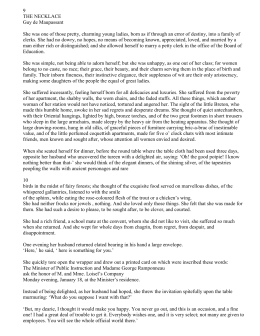

Ironically, in Mathilde’s desire to “prove herself worthy” she loses what little she has and finds herself worse off.

It is a true to life cautionary tale that still applies today. The overarching theme is that of dissatisfaction and the dangers inherent in false self-fashioning. It was worth at most 500 francs!” (Maupassant, 1880) Mathilde explains the whole ordeal to which the friend exclaims, “Oh, my poor Mathilde! Why, my necklace was paste. She runs into her friend who wonders at her appearance. At the end of ten years, Mathilde is haggard and defeated. They then spend ten years working in a deprivation that she had not experienced before. Unsurprisingly, the necklace is lost and, rather than explain the mishap to her friend, Mathilde convinces her husband to borrow a significant amount of money to purchase a replacement. She receives an invitation to a ball and must have a new ball gown and borrows jewels from a friend.


“She suffered ceaselessly, feeling herself born for all the delicacies and all the luxuries” (Maupassant, 1880). “The Necklace” tells the story of Mathilde, a malcontent housewife who imagines herself deserving of more prosperity and societal influence. Increasing literacy rates made literature more popular and also more influential. Over-crowding in cities and poor working environments provided ample material for Realist artists and writers who concentrated on displaying the reality of individual life, particularly the common man who was most affected by these changes. Technological developments such as the cotton gin, inspired farm workers to move to more urban areas looking for better jobs. The Industrial Revolution had changed the landscape of western civilization. “The Necklace” was written in 1884, during the Realist Period which spanned from the mid 19th century to the early 20th century.


 0 kommentar(er)
0 kommentar(er)
